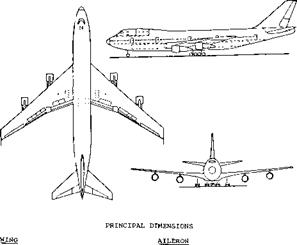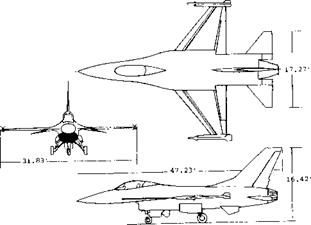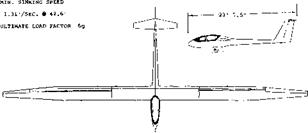LIFT OF AIRPLANE CONFIGURATIONS
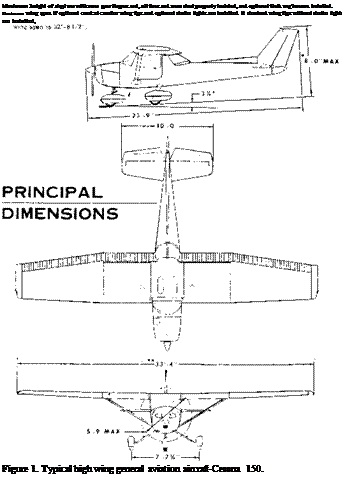
The lift of a complete airplane is determined by the characteristics of all its components and their mutual interactions as discussed throughout the previous chapters of this book. The total lift of the complete airplane determines its performance, especially with regard to takeoff, landing, maneuver, climb, stability and safety. This lift characteristic effects the capability of the airplane with regard to maximum gross weight and range and is determined by the configuration, the flaps and gear position. Since we are interested in the overall performance, the complete airplane is considered in this chapter. The methods and equations needed for determining the performance characteristics of the airplane are given in Chapter I as these concepts are used throughout the book. While we are interested in the complete airplane system we will not attempt to present detailed procedures for establishing the total design. The complete aircraft can only be designed by considering all the factors discussed in the preceding chapters as well as drag as presented in the book “Fluid Dynamic Drag” (l, a) and the type of data given in (l, b). Of course, the propulsion system and mission are also important considerations in the design of the complete airplane.
1. CONFIGURATION TYPES
To arrive at the best airplane configuration to satisfy a given requirement there are hundreds of possibilities to be considered. Of these, the actual configurations that have been used and considered are numerous and varied. These include aircraft with various wing arrangements including single wings, biplanes, triplanes (2,a), swept wing, delta wings, full flying wings, swing wings and no wings at all. The type of wing, fuselage and empennage configuration that is best depends on many factors such as the powerplant, mission speed and payload. As a result it appears that to meet certain requirements the configuration selected by various designers are remarkably similar. For this reason a few typical airplane configurations with examples, as given on Table 1, are presented. The characteristics of any specific airplane can usually be found in (2,b, c).
(1) Complete aircraft design:
a) Hoerner, Fluid Dynamic Drag.
b) Wood, Aerospace Vehicle Design, Vol. 1.
(2) Airplane configurations:
a) Triplanes. As reported in “Heroes and Aeroplanes” (Grosset, New York 1966) a famous triplane was the ‘ Sopwith” flown in WWI (1917) using a 120 HP rotary engine. There was also a Fokker triplane, with a maximum speed of 100 mph and the Curtiss Model S-3 “Wasp” with a speed of 160 mph (1919).
b) Janes All World Aircraft, published yearly.
c) Mil А/С Specification Sheets.
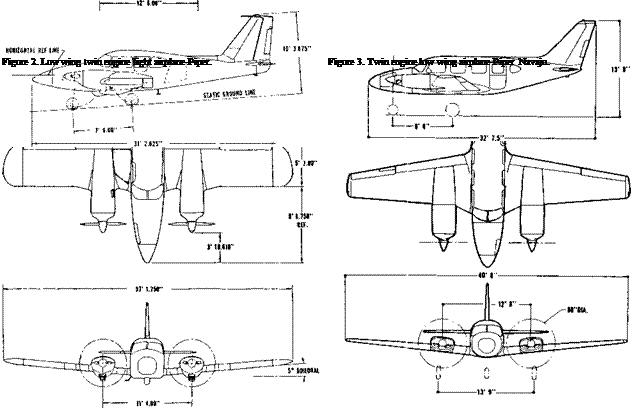 |
General Aviation Aircraft. The characteristics of typical general aviation aircraft types are listed in Table 1, (2,b). These are generally fairly simple one or two engine aircraft with a single forward wing attached to a central fuselage with stability provided with a horizontal and vertical tail, as illustrated on figures 1 to 4. Both high and low wing configurations are found. In most cases, tractor – propellers are used to provide thrust for overcoming drag, although both underwing and aft jet engines are also used. General aviation aircraft are generally designed for speeds under 300 MPH with stalling speeds under 70 MPH for single engine airplanes of 6000 pounds or less. Also considered under the general aviation heading are business jets which have nearly the speed capability of transport aircraft.
(3) Aircraft design considerations:
a) , Swihart, Jet Transport Design, AIAA Selected Reprints VIII.
b) Olason, Performance of 747 Airplanes, JofA/C, Vol. 6 No. 6 ’69.
c) Olason, Aerodynamic Design Boeing 737, JofA/C, Nov., Dec. 1966.
(4) Special aircraft:
a) Strong, Sky Surfing with Low-speed Wings, Scientific American. Dec. 1974. See also, Fink, Sailwing of A = 5.9 NASA TN D-5047.
b) Motorless Flight Research, NASA CR-2315, 1973.
c) Mitcovich, “Man-Powered Flight: Achievements to Date” J А/С Vol. 7, No*3.
d) Gilbert, “Grunts, Groans & Gossamer Wings”, Air Progress, Apr. 1973.
|
а/с type |
EXAMPLE |
NO. |
G. W.. |
W. E. |
b |
A |
S c MAX |
VS |
VCRUISE |
VMAX |
FIGURE |
|
|
ENGINES |
FT. |
HP or T |
KTS |
KTS |
KTS |
NO. |
||||||
|
PER ENG. |
||||||||||||
|
GENERAL AVIATION |
||||||||||||
|
LIGHT SINGLE ENGINE CESSNA 150 |
1 |
1,600 |
990 |
33.5 |
7 |
160 |
0 100′ |
34 |
106 |
1©9 |
1 |
|
|
TWIN ENGINE |
PIPER AZTEC |
2 |
5,200 |
2» 042 |
37.2 |
6.7 |
206 |
0 250 |
61* 66 |
181 |
2 |
|
|
MEDIUM TWIN ENGINE |
PIPER NAVAJO |
2 |
6,500 |
3 900 |
40’8" |
7.3 |
229 |
0 310 |
63* 70 |
218 |
226 |
3 |
|
JET TWIN ENGINE |
CESSNA |
2 |
11,650 |
6,454 |
43.9 |
7.4 |
260 |
2200 |
347 |
347 |
4 |
|
|
TRANSPORT |
||||||||||||
|
LIGHT |
DOUGLAS DC-9-40 |
2 |
114,000 |
55,500 |
93.4 |
14,500 |
124 |
490 |
5 |
|||
|
MEDIUM |
BOEING 727-200 |
3 |
191,000 |
96,600 |
108 |
7.2 |
1560 |
14,500 |
129 |
449 |
521 |
6 |
|
HEAVY |
LOCKHEED L-1011 |
3 |
426,000 |
234,300 |
155 |
42,000 |
139 |
498 |
538 |
7 |
||
|
BOEING 747 |
4 |
710,000 |
355,700 |
195.7 |
6.96 |
5500 |
47,000 |
140 |
503 |
556 |
8 |
|
|
MILITARY |
||||||||||||
|
FIGHTER – F16 |
GD – F16 |
1 |
21,500 |
13,800 |
31.8 |
3.6 |
280 |
M=2+ |
9 |
|||
|
BOMBER |
BOEING B-52H |
8 |
488,000 |
185 |
8.6 |
4000 3^17,000 |
577 @ |
10 |
||||
|
CARGO |
LOCKHEED C-130 |
4 |
155,000 |
70,140 |
132.6 |
10 |
1745 |
0 4591 |
296 |
20,000′ 336 |
11 |
|
|
LOCKHEED C-5A |
4 |
728,000 |
327,000 |
222.8 |
8. |
6200 |
25° |
460-480 |
12 |
|||
|
SAILPLANE |
CALIFORNIA al4 |
0 |
954 |
617 |
66.9 |
25. |
173 |
0 |
34 |
13 |
|
TABLE 1 |
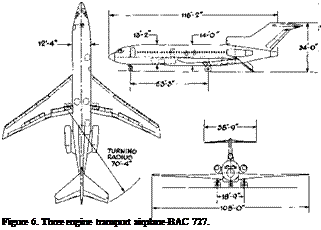 |
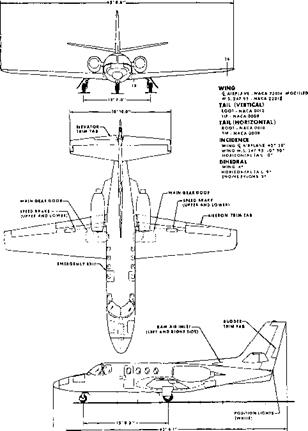 |
= HP * FLAPS & GEAR DOWN
Figure 4. Twin jet airplane for general aviation-Cessna.
Transport Aircrafts Nearly all commercial transport aircraft use turbine engines and most of these use jet engines with various ratios of engine to bypass air. It is convenient to classify the aircraft in terms of low, median and long range types with typical characteristics as given on Table 1. The short range transport types may use propellers;however, increasing numbers of aircraft are now powered with turbo fan engines. Almost all the median and long range transport aircraft have a large single swept wing forward and a normal type empennage for stability and control. The jet engines are generally placed below the wing or aft on the fuselage. Some examples of transport aircraft are given on figures 5 to 8.
The details of the philosophy used in the design of transport aircraft are given in (3,a, b,c). Here, reasons are given for the selection of the engine location, horizontal tail position, high lift devices and other factors that make up a successful transport type aircraft. The selection, design and evaluation of the wing and its flap systems for aircraft in this class are covered in Chapters XV and XVI as well as throughout this book.
|
|
|
AREA |
5500 Sq. Ft. |
AILERON AREA (INBD) |
71.8 Sq. Ft. |
|
SPAN |
195 Ft. 8 In. |
(OUTBD) |
153.4 Sq. Ft. |
|
BASIC ROOT CHORD TIP CHORD |
449.68 In. 160.00 In. |
HORIZONTAL TAIL |
|
|
TAPER RATIO |
.356 (Basic) |
AREA |
1470 Sq. Ft. |
|
DIHEDRAL SWEEPBACK c/4 |
.245 (Ref) |
SWEEPBACK c/4 |
37.5° |
|
70 37.5° |
SPAN |
72 Ft. 9 In. |
|
|
ASPECT RATIO (REF) |
6.96 |
VERTICAL TAIL |
|
|
FLAP |
AREA |
830 Sq. Ft. |
|
|
SWEEPBACK c/4 |
45° |
||
|
LEADING EDGE AREA |
SPAN (HEIGHT) |
32 Ft. 3 In. |
|
|
(RETRACTED) TRAILING EDGE AREA (RETRACTED) |
448 Sq. Ft. 847 Sq. Ft. |
BODY LENGTH |
228 Ft. 6 In. |
|
Figure 8. Heavy four engine transport-BAC 747. |
|
Figure 7. Three engine air bus type-LAC 1011. |
Military Aircraft. Examples of the characteristics of various types of military aircraft are also given on Table 1. These aircraft range in size and type with their performance capability being established by the requirements of specific missions, figures 9 to 12. These aircraft are designed for such missions as training, low level attack, reconnaissance, interception, bombing and cargo.
Lift and its characteristics are of primary importance in the design of military aircraft. For instance, the maximum lifting characteristic is of primary concern in flight because of the need for high maneuverability. The need for high lift is thus of primary importance in the design of attack interceptor type aircraft. In the case of bomber and military transport type the requirement for high lift is similar to that of conventional aircraft, as discussed in Chapters I, VII and VIII.
|
Figure 9. General arrangement and dimensions-F-16. |
Figure 10. Heavy bomber-B-5 2.
Special Aircraft. There are many other aircraft types to be considered and these can lead to some very unusual types of configurations. Such aircraft can range from configurations designed to operate at extremely high altitude to vehicles designed to operate only in ground effect. These special aircraft include: gliders for sport, sky surfing (4,a), high performance sailplanes with lift drag ratio as high as 45, (4,b). Also, man powered airplanes may be considered (4,b, c).
(5) Variable geometry aircraft:
a) Baals & Polhamus, Variable Sweep Aircraft, A & A Engr., June 1963.
b) 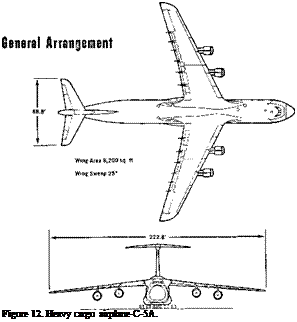
 |
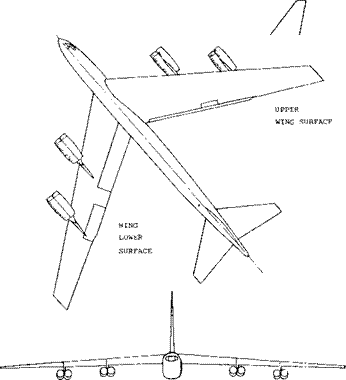 |
Jones, R. T., New Shape for SST, A&A Engr. Dec. 1972.
|
ТЕ1- 10.5" ~ |
|
BEST GLIDE RATIO. 49:1 ® 49 KTS
Figure 13. Sail plane – California a-14, general arrangement. |
Sailplane Design. The design of high performance sailplanes such as are illustrated in figure 13 requires extreme attention to detail to achieve lift drag ratios in the 40 range with corresponding low rates of sink, since for a glider
tan 6 = D/L (1)
Where 6 is the gliding angle and must be kept as low as possible for good performance. The drag is, of course, equal to the total profile and induced value. High performance sailplanes now use very high aspect ratio wings with airfoils designed especially for low drag and high lift coefficients (4,b). The frontal area is reduced to an absolute minimum by having the pilot in nearly a prone position. With these design features and attention to design details as discussed in (l, a), very high lift drag ratios are obtained.
Hang Gliders. There is a growing sport in the use of hang type gliders such as are illustrated on figure 14. Although hang type gliders date back to the beginning of aviation, the development of the light weight Rogallo delta type wing, as discussed in Chapter XVIII, and similar wings (4,a) covered with sail cloth has made possible a new and exciting sport. In the design of hang gliders the lift drag ratio is on the order of 5 with the low aspect ratio delta wing, and up to approximately 10 with the more advanced configurations using sail type wings. The importance of aspect ratio in reducing the induced drag is well illustrated here.
|
Figure 15. Swing wing bomber airplane-B-1. |
![]()
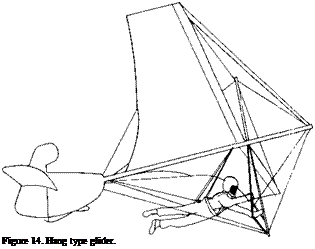
Variable Geometry Configurations. Most of the airplane types listed in Table 1 have at least trailing edge flaps and may thus be considered to be variable geometry type aircraft. Some of the vehicles listed have extensive systems of flaps and slats, so much so that it often appears that the wing is coming apart especially during landing. Because of extensive demands for lift and drag, especially between the high speed and landing conditions, even greater differences in the aircraft configuration are required. As a result, aircraft have been designed with wings that pivot in such a way that we effectively have a variable sweep wing. An example of such an aircraft is given in figure 15 and the theory and reasons for such configurations are given in (5,a). A further unusual variable geometry concept is given in figure 16. Here the entire wing swings. This concept is discussed in (5,b) and offers some solid advantages in overall performance.











